The Essential Guide to Windsurfing Harnesses
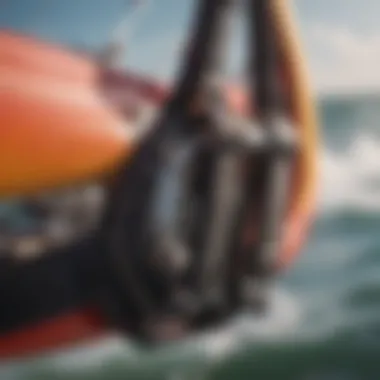
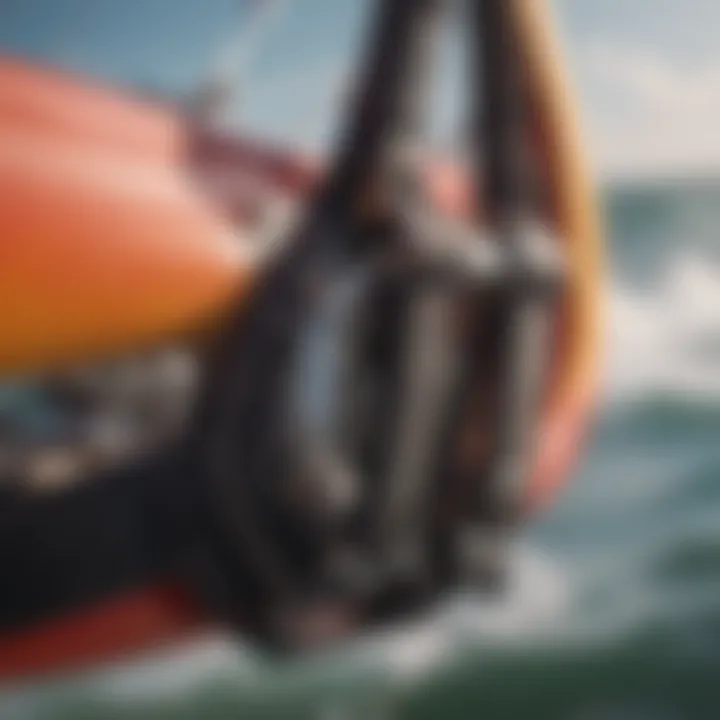
Intro
Windsurfing brings together the exhilaration of surfing and the power of sailing. To navigate the waves smoothly, having the right equipment, especially harnesses, is key. The harness is not just an accessory; it’s essential for stability and control. Think of it as the anchor for your body against the force of the wind, allowing you to harness its energy effectively.
A good harness aids movement, distributing the force of the sail. When you’re flying across the water, that balance is crucial. It’s not just about comfort; it’s about enhancing your performance and extending your time on the board. In this guide, we will look at various kinds of harnesses, their construction features, and how they play an integral role in your windsurfing experience.
Techniques and Tips
Skill Development
Before diving into the gear, let’s touch on skills. Mastering windsufing requires practice and strategy. Here are a few pointers:
- Foot positioning matters: Proper stance can drastically affect how you control the sail.
- Keep your body loose: A tense body can yield quick fatigue.
- Look ahead: Focus on where you're going instead of the water right in front of you. This helps in maintaining balance while navigating waves.
Practical Techniques
The way you use your harness also plays a role in performance. Here are some practical techniques to enhance your ride:
- Engage your core: A strong core keeps your body stable and responsive. When adjusting your weight, your core will keep your movements controlled.
- Learn to adjust: Knowing how to adjust your harness on the fly can save you discomfort and allow better control.
- Connection with the sail: Stay connected with the sail through your body; use your harness to transfer the sail's power into your movements.
Common Mistakes to Avoid
Even seasoned windsurfers can slip up. Here’s what to look out for:
- Over-gripping the boom: This can tire you out quickly. Keep a light hold.
- Ignoring the harness position: Making sure it sits correctly prevents aches and lets you move freely.
- Not using a waist harness for freestyle: If you want to try tricks, consider a seat harness for more support.
"The right harness makes a world of difference in windsurfing. It’s not merely about getting one; it’s about choosing wisely."
Gear and Equipment
Essential Gear for Beginners
For those starting, a reliable harness is non-negotiable. Some key options for beginners include:
- Seat harness: Offers better lower back support, making it easier for newcomers to manage.
- Waist harness: Good for balance; transitions to advanced moves easily.
Latest Innovations and Trends
Windsurfing gear has come a long way. Here are some innovations changing the game:
- Lightweight materials: Modern harnesses are built with lightweight yet durable fabrics, improving comfort.
- Quick-release systems: Easier for safety, these allow for fast disengagement from the sail under duress.
Reviews and Comparisons
When selecting a harness, consider how they stack up against each other. Websites like reddit.com provide valuable insights from real users comparing options.
Safety Measures
Essential Safety Gear
Riding the waves carries risks, and harnesses are only part of the equation. Don't skimp on safety gear:
- Life jacket: Your first line of defense against drowning.
- Helmets: Protects your head during falls.
- Impact vests: Offers additional buoyancy and protection against impacts.
Best Practices for Safe Participation
- Check weather conditions: Wind strength and direction can significantly affect your ride.
- Know your limits: Push yourself, but know when too much is too much.
- Practice with experienced windsurfers: Their experiences can guide you smoothly.
Injury Prevention and Management
A smooth ride means being aware of possible injuries:
- Keep your body warm before a session to avoid strains.
- Stretch regularly to maintain flexibility.
- Know first-aid basics in case of accidents.
Closure
In summary, understanding windsurfing harnesses is crucial for enjoying the sport safely and effectively. Choosing the right type of harness brings comfort and control, letting you focus on the thrill of riding the waves. Be mindful of your skills and safety, and apply the techniques discussed to enhance your performance. With the right knowledge and gear, you can elevate not just your windsurfing experience, but also your passion for the sport.
Understanding the Windsurfing Harness
Windsurfing harnesses play a vital role in ensuring both performance and enjoyment in the sport. As you glide over the water, the harness provides a connection between the windsurfing rig and your body, allowing enhanced control and reduced strain on your arms. This goes beyond mere comfort; it directly affects how effectively you can maneuver the board and sail. A well-chosen harness fosters confidence, enabling you to push your limits while staying safe and secure.
Definition and Purpose
A windsurfing harness is a piece of equipment worn by windsurfers to support their connection to the sail. It allows riders to utilize the power of the wind without solely relying on upper body strength. Rather than holding on tightly to the boom, which can be exhausting and lead to fatigue, the harness shifts the load to your hips or seat, promoting a more relaxed stance. This function not only enhances endurance but also improves performance, as it frees your hands to adjust the sail more dynamically.
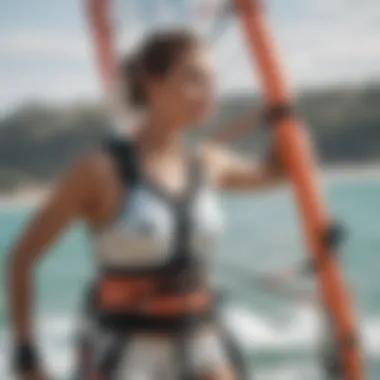

The harness generally consists of straps made from durable materials, a padded torso section for comfort, and a hook where the lines from the sail connect. It effectively balances support and freedom of movement, making it easier to ride under various conditions. This equipment is not just functional; it is a cornerstone of windsurfing ergonomics.
Historical Context
Understanding the historical development of windsurfing harnesses gives insight into their evolution and current designs. In the early days of windsurfing, around the late 1960s, riders would grip the boom tightly with their arms, leading to rapid exhaustion. This situation spurred innovation. The idea of a harness began to gain traction as enthusiasts sought ways to achieve longer rides and better performance.
Initially, harnesses were quite rudimentary. They were often just simple straps without much thought given to comfort or ergonomics. As the sport gained popularity in the 1970s and 1980s, manufacturers began optimizing designs, focusing on user comfort and adjustability. People started experimenting with different materials and styles, laying the groundwork for the waist and seat harnesses we see today.
Encouraged by a growing community, advancements in technology also led to the introduction of specialized harnesses catering to various windsurfing styles. This progression illustrates the community's influence on harness design, shaping not only functionality but styles as well. These changes underscore the importance of harnesses in enabling riders to fully enjoy their windsurfing experience.
"The harness is your bridge to the wind; it’s what allows you to dance with the elements."
As we dive deeper into the types of windsurfing harnesses, materials, and maintenance practices in the upcoming sections, it's essential to appreciate how the understanding of harnesses has set the stage for today's innovations. This foundational knowledge prepares you to select a harness that mirrors your personal style while optimizing your time on the water.
Types of Windsurfing Harnesses
Understanding the various types of windsurfing harnesses is crucial for any enthusiast looking to enhance their performance and overall enjoyment of the sport. Not all harnesses are created equal; each type provides specific benefits tailored to different riding styles, comfort preferences, and skill levels. By selecting the right harness, you not only improve your technique but also increase your comfort level on the water, which can make all the difference on a long day out on the waves.
Waist Harness
The waist harness is a popular choice among many windsurfing enthusiasts. It fits snugly around the waist, providing a great combination of support and mobility. This design allows for a more upright sailing position, which is favorably linked to certain styles, like freeriding. The key characteristic of the waist harness is its ability to maintain a high level of control while still allowing for flexibility in movement.
Often, riders prefer this type because it generally allows them to feel more connected with their board. However, it is essential to ensure a proper fit; if it's too loose, it can slide up or down, causing discomfort during use.
Seat Harness
In contrast to the waist harness, the seat harness offers more lower-back support and is frequently favored by beginners and those who may struggle with back issues. By sitting lower on the body, it spreads the load across the hips rather than just the waist. This aspect provides an added sense of security, which can be instrumental for those still mastering their skills.
Additionally, this design lowers the center of gravity, enabling the rider to handle the board more smoothly in choppy water. The trade-off is that the seat harness can restrict upper body movement slightly more than the waist style, but many riders still find it a trade worth making.
Specialty Harnesses
Speed Harness
The speed harness is specifically designed for windsurfers who are in pursuit of maximum speed. This type of harness is often thinner and more streamlined compared to its counterparts. The key characteristic here is the aerodynamic design, which allows for less drag while speeding across the water. This feature can be a game-changer for riders participating in racing events or speed challenges.
However, the thin design sometimes means less padding, which might not be comfortable for sessions that last for hours. For those who prioritize speed over comfort, the benefits can easily outweigh any disadvantages.
Freestyle Harness
Designed for mastery of tricks and acrobatics, the freestyle harness is all about flexibility. The main aspect of this type is that it allows maximum freedom of movement, which is vital for performing high-flying stunts and complex maneuvers. Riders appreciate this harness for its ability to enable quick movements without restrictions. Although it’s highly favored among freestyle enthusiasts, it may not provide the same level of support as other harnesses, particularly during long-distance rides. Therefore, it is essential to weigh the benefits against personal riding styles and preferences.
"Choosing the right harness is not just about comfort; it can greatly affect your performance on the water. Think critically about your riding style and needs before making a decision."
In summary, the choice between waist, seat, and specialty harnesses boils down to individual needs and riding styles. Selecting the appropriate harness not only elevates performance but also impacts your comfort and enjoyment while windsurfing.
Materials Used in Harness Construction
When it comes to windsurfing harnesses, the materials utilized in their construction can make all the difference in performance, durability, and comfort on the water. An understanding of these components not only enhances your knowledge but also aids in making informed choices when selecting a harness that fits your adventure needs. The right materials can optimize how effectively you can control your windsurfing board, so let’s dive into the key elements of harness construction.
Webbing and Straps
The webbing and straps of a windsurfing harness are significant for the reclaim of power from the sail, allowing for a more direct connection to the board. Typically made from strong synthetic materials such as polyester or nylon, these webbing elements must withstand intense tugging and stretching without losing their integrity.
- Durability: A harness’s webbing needs to be resistant to wear and tear, particularly against the elements. Constant exposure to saltwater and UV rays can weaken materials over time.
- Weight: It’s essential that the webbing is lightweight yet robust. This balance ensures that the harness doesn’t hinder your movements – you want to feel free while paddling out.
- Adjustability: Well-designed webbing allows for easy adjustments, helping it fit snugly against your body. If it feels loose or too tight, it detracts from your experience on the water.
Remember, having too much slack can allow unwanted movements, affecting your control. Aye! So, it’s critical to find the perfect fit.
Padding and Comfort Features
In the high-octane world of windsurfing, comfort can’t be an afterthought. Padding features in harnesses are designed not just for comfort, but also for support during those exhilarating rides.
- Types of Padding: Different harnesses come with varying levels of padding, often made from materials like neoprene or EVA foam. These choices provide cushioning against jolts from the waves while also protecting your body from chafing.
- Ventilation: Some harnesses include mesh panels that allow for airflow, keeping you cool even as you sweat it out. This is particularly vital on hot days or long sessions, preventing discomfort that can distract from your performance.
- Ergonomic Shapes: Many modern harnesses are designed with ergonomic shapes that contour to the body, ensuring that pressure is evenly distributed. This design helps reduce fatigue over long periods of use.
"A well-constructed harness can feel like a second skin, allowing you to push your limits without being held back."
Selecting the right combination of materials is crucial for any windsurfer aiming for the thrill of high-speed rides or tricky maneuvers. Remember that a well-constructed harness doesn’t just improve your performance; it can also elevate your entire windsurfing experience.
How to Choose the Right Harness
Choosing the right harness can make all the difference in your windsurfing experience. It goes beyond simply picking a piece of equipment; it’s about understanding how various features align with your riding style, body shape, and comfort preferences. The right harness can enhance your performance, reduce fatigue, and even help in injury prevention.
When selecting a harness, two main elements come into play: size and fit as well as the activity type you'll engage in. Each of these factors has a major impact when it comes down to your overall satisfaction and effectiveness on the water.
Size and Fit Recommendations
Finding the right size and fit is crucial because if a harness is too loose, it could ride up and cause discomfort, whereas a tight harness could limit your movements and breathing. Generally, sizes are classified based on waist measurement, and it’s best to consult the sizing chart provided by the manufacturer. Measure the circumference of your waist where the harness will sit, and look for harnesses that offer a range of sizes. In addition to sizing, consider how adjustable the straps are; a flexible harness often allows for more comfort.
Another aspect to bear in mind is how the harness interacts with your body. For instance, if you have a broader or narrower torso, certain shapes might fit you more comfortably. Aim for a snug fit without compromising on circulation or movement.
Focus on Activity Type
Depending on the kind of windsurfing you're planning to do, certain harnesses may suit your needs better. Here’s a deep dive into three distinct disciplines:
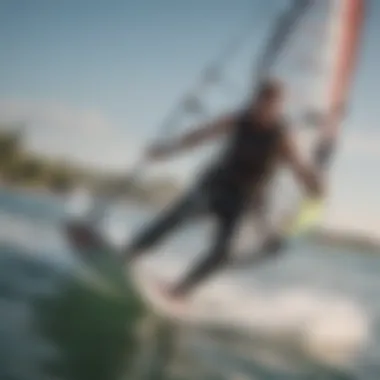
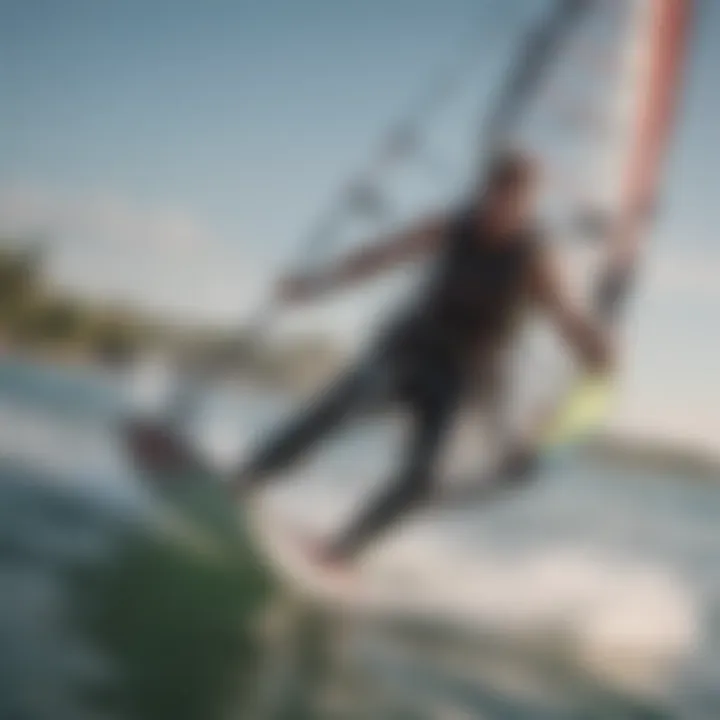
Freeride
In freeride windsurfing, the focus is on enjoying the ride, exploring different terrains, and mastering various techniques at a leisurely pace. The key characteristic here is flexibility. A freeride harness typically offers a moderate level of support while enabling a good range of motion. This is crucial for making smooth turns and adapting to unpredictable conditions.
The unique feature of a freeride harness is often its combination of a lower back design and wide straps. These features enable greater freedom of movement while still providing support. One of the advantages is that these harnesses are usually more comfortable over long sessions. However, for more intense moves or providing extra hold during strong winds, they might sometimes lack the rigidity you would find in more specialized harnesses.
Racing
When you step into racing, agility and power are the name of the game. Choosing a racing harness usually revolves around maximizing performance and minimizing drag. The key characteristic of racing harnesses is their streamlined shape. They are typically designed to sit lower on the hips, providing a direct connection that allows for efficient energy transfer to the sail.
A racing harness often has specific features such as reinforced materials and a more rigid construction to withstand those incredibly tight maneuvers at high speeds. The downside? These harnesses may feel less comfortable for relaxed riding, as they prioritize performance over comfort.
Freestyle
For those heart-pounding tricks and jumps, a freestyle harness is the way to go. What sets freestyle harnesses apart is their focus on control during aerial maneuvers and rapid rotations. The key characteristic here is support without sacrificing flexibility. Often crafted with additional padding and wider straps, these harnesses provide the balance needed for jumps while securing you firmly during flips.
One advantage is their adaptability; they're generally made to accommodate sudden moves and provide enough core support without being restrictive. The downside? They may not be as comfortable on longer rides compared to freeride options, but they excel in aiding performance during stunts.
"Choosing the right harness is like picking the right shoes for a marathon; it's all about fit and suitability to the task at hand."
In summary, whether you’re freeriding, racing, or showing off your freestyle skills, understanding the nuances of each type of windsurfing harness allows you to make an informed decision that enhances your performance and overall enjoyment.
Setting Up and Adjusting Your Harness
When it comes to windsurfing, the performance and safety of the ride hinge significantly on how well you set up and adjust your harness. An improperly adjusted harness can lead to discomfort, decreased control, and increased risk of injury. Not only that, but a well-fitted harness can enhance your efficiency on the water, allowing you to focus on mastering the wind and waves instead of fidgeting with your gear. This segment delves into the fine details of harness adjustment, ensuring that every windsurfer can sail with confidence and enjoyment.
Proper Adjustment Techniques
The crux of a good harness experience is how well it fits the body. Incorrect adjustments can throw off your balance and make it difficult to maneuver. Here are some essential techniques for achieving the right fit:
- Strap Tightness: Adjust straps around your waist or seat for a snug fit. Tight doesn’t mean uncomfortable; you want it secure without pinching.
- Back Support: Ensure that the back of the harness aligns with the lower spine and provides adequate support.
- Positioning: The harness should sit comfortably on your midsection or hips, preventing it from moving up when rigged correctly.
- Trial and Error: Don’t be afraid to make small adjustments while rigging your sail and test them on the water. Feedback from how the harness feels in action is invaluable.
Good adjustment not only enhances comfort but also optimizes your body mechanics. A clearly adjusted harness facilitates better movement, allowing for fluid transitions between maneuvers.
Connection to the Board
Once your harness sits well on your body, the next step is to connect it to the board confidently.
The connection point—the hook—plays a vital role in how effectively energy transfers from the sail to the harness and then to your body. This is crucial for harnessing the wind's power effectively. Here are some key points:
- Connection Method: Make sure that your harness hook securely attaches to the harness lines. A loose connection can cause unexpected disconnections, which could lead to falls.
- Hook Placement: Adjust where the hook connects. A higher placement can increase the load on your body, while a lower placement might give you more control during acceleration.
- Harness Lines: Check the lengths of the harness lines frequently. They should complement your positioning on the board and suit your style of sailing. Misalignments can affect balance and performance.
- Practice Releases: Know how to quickly release from your harness if needed. Spend a little time practicing this on land, as it could make a significant difference in emergency situations.
By mastering the connection between your harness and the board, you maintain optimal control and responsiveness, allowing for a more enjoyable experience on the water. As you adjust and connect, keep in mind that practicing these techniques regularly will help solidify your comfort and skill level in windsurfing.
"The right setup can turn your windsurfing experience from basic to unforgettable."
With the understanding of setting up and adjusting your harness, you will be better positioned to tackle the challenges the wind presents, enhancing not just your performance, but safety as well. This foundational knowledge will serve you well as you navigate through the thrill of windsurfing.
Maintenance of Windsurfing Harnesses
Maintaining your windsurfing harness is vital for ensuring not merely its lifespan but also your own performance and safety on the water. Just like a trusty old pair of sneakers, a harness needs care to keep it in prime working condition. Regular maintenance not only emphasizes your commitment to your gear but can save you a hefty sum in the long run by preventing costly replacements. With the right approach, your harness can serve you well through many thrilling sessions.
Regular Inspection and Care
Conducting regular inspections of your harness is more than just a good habit; it's essential. Make it a routine to check every strap, buckle, and seam for signs of wear and tear. A stitch in time saves nine, and this old saying rings particularly true when it comes to windsurfing harnesses. Look out for frayed straps or damaged buckles, as these can significantly impact the performance of your gear.
Here are some practical tips to keep your harness in peak condition:
- Check for frays: Inspect all straps and seams for any signs of fraying.
- Buckle function: Ensure the buckles are secure and not malfunctioning. A broken buckle can lead to serious issues on the water.
- Padding assessment: Feel the padding for any compressions that could reduce comfort.
- Drying properly: Following a session, make sure the harness is properly dried to prevent mold and mildew. Avoid folding it while wet.
By staying proactive and inspecting your equipment, you can catch issues before they escalate into something more serious.
Repairing Common Damage
Accidents can and do happen; it’s all part of the wild adventure of windsurfing. While some wear is simply a badge of honor, knowing how to tackle common issues can really extend the life of your harness.
Some common damages and their quick remedies include:
- Torn Straps: If you notice a tear, a simple sewing kit can come in handy. Use strong thread to re-stitch the area if it’s a minor issue. For larger tears, consider a professional repair service.
- Broken Buckles: If a buckle snaps, don’t toss the whole harness! Many times, you can simply replace the buckle. Just look up the manufacturer’s specifications online to find the right part.
- Padding Damage: For padding that has squashed down or gone hard, you might be able to replace it or use some foam padding to DIY a comfortable fit. You want to feel snug, not squished!
- Rusty Components: If you’ve got metal parts, a bit of corrosion might emerge over time. A light cleaning with rust remover and a water-resistant spray can help protect against future rust.
Remember: It's often cheaper to repair than to replace. Take care of your harness, and it can take care of you back.
Innovations in Harness Design
The evolution of windsurfing harnesses has reached new heights in recent years. Innovations in harness design not only enhance performance but also improve safety and comfort for riders. As the sport itself evolves, the need for sophisticated and effective harness solutions becomes increasingly imperative. By integrating advanced technologies and materials into the design of harnesses, manufacturers have ensured that windsurfers can engage in their sport with better control and reduced fatigue.
Advancements in harness design involve redefining how these pieces of equipment function and interact with the body. To put it simply, a well-designed harness acts like an extension of the windsurfer, allowing the rider to transfer their movements more seamlessly and efficiently to the board. This factor is crucial, especially when competing or navigating through choppy waters where precision in control equals success.
Technological Advancements


The winds of change are tangible in the realm of windsurfing harnesses. Various technological advancements have emerged, pushing the boundaries of traditional designs to cater to the needs of current users. Here are several noteworthy advancements:
- Smart Fabrics: Modern harnesses are beginning to utilize smart materials that adapt to the surrounding conditions or the body’s movements. For instance, some harness users may witness temperature-regulating effects thanks to advanced fabrics that keep the temperature stable during long hours in the sun.
- Integrated Safety Features: Newer designs often embed safety mechanisms directly into the harnesses. For example, some include quick-release systems that allow a rider to detach from the board in case of a fall, enhancing safety during intense maneuvers.
- Ergonomic Designs: With research focused on human anatomy, harnesses are now sculpted to fit the body’s contours more naturally. This reduces common discomfort, allowing surfers to focus more on the ride rather than battling against a poorly fitting harness.
Through these innovations, harnesses not only become tools for performance but also act as safety nets for enthusiasts engaging in potentially risky maneuvers.
Future Trends in Design
As we gaze toward the horizon, it’s clear that the future of windsurfing harness design promises to be as dynamic as the sport itself. Anticipated future trends include:
- Sustainability: An increasing awareness of environmental issues is leading manufacturers to seek eco-friendly materials in harness production. This shift will not only reduce environmental footprints but also appeal to eco-conscious windsurfers.
- Modular Systems: Future harnesses might allow users to customize their equipment to a greater degree. Modular harness systems may let riders swap components as per their requirements, depending on their activity or the conditions of the day.
- Increased User Feedback: Harness manufacturers are leaning into technology by developing ways for users to provide real-time feedback directly from the water through GPS and other tracking devices. This data may guide future designs and improvements significantly.
These upcoming trends are not just about keeping pace with user demands. They represent a deeper understanding of how equipment affects performance and enjoyment in the sport of windsurfing.
Safety Considerations
When it comes to windsurfing, safety cannot be tossed aside like an old wetsuit. Harnesses, while primarily known for aiding performance, play a crucial role in minimizing risks associated with the sport. Understanding the nuances of safety considerations ensures that thrill-seekers enjoy the adrenaline without unnecessary hazards.
Harness Usage and Risk Management
Using a harness effectively requires more than just buckling up and hopping on the board. For starters, an improperly adjusted harness can lead to discomfort and even accidents. Imagine being out on the water and suddenly feeling that familiar pinch in your lower back or your kite swinging wildly without much control—definitely not the kind of thrill one signed up for!
- Weight Distribution: Everyone has a different body type, so the way weight is distributed is key. A properly fitted harness transfers forces evenly across the body. This minimizes strain on any one part, particularly the lower back, reducing the risk of injury.
- Connection Point: The way your harness connects to the board matters too. Ensure that the harness lines are securely attached, and avoid using worn-out or frayed lines. Keep them tight, but not so tight that movement is restricted—striking that balance is essential.
- Practice Safety Protocols: Understanding the basics of what to do in case of a mishap can save lives. Practice unhooking and re-hooking in calm conditions before tackling the waves. Familiarize yourself with the emergency procedures in the area where you're windsurfing.
To sum it all up, thoughtful usage of the harness helps manage risk effectively while maximizing your enjoyment of the sport.
Emergency Release Mechanisms
No one likes to think about emergencies, but let's face it—unexpected situations crop up all the time when you're out on the water. That's where emergency release mechanisms come into play, acting like a safety net when things go awry.
An effective emergency release allows you to disconnect from your equipment quickly. This could be crucial in scenarios like losing control or facing an unexpected change in wind conditions.
- Types of Releases: There are generally two types of releases in harness systems: manual and automatic.
- Manual releases need a swift tug or a push, allowing the user to disconnect intentionally. It's vital to practice this—nobody wants to fumble just when they need it most!
- Automatic releases work by tension and are designed to let go when a certain load threshold is surpassed—this can be lifesaving during sudden falls or tacks gone awry.
It’s worth mentioning that not all harnesses come equipped with top-notch release mechanisms, so it’s prudent to check this feature when shopping around. Maintaining and checking your mechanisms ensures they work when it’s crunch time. Routine inspections can save a windsurfer from hazardous entanglements on the water.
Remember: In the heat of an unexpected moment, having a reliable emergency release can be the difference between a thrilling adventure and a nightmare scenario.
The Role of Community in Windsurfing
Windsurfing isn't just an individual sport; it's much more than that. The community plays a crucial role in shaping the experiences of both novices and seasoned surfers alike. Whether you are catching your first waves or flying through the air with finesse, the input and support of fellow windsurfers can enhance your journey immeasurably.
The sense of belonging, sharing knowledge, and camaraderie created by local windsurfing clubs or online forums can cultivate a rich environment for learning and growth. Let's dive into how peer influence can shape equipment choices and personal experiences in this thrilling aquatic sport.
Influence of Peer Recommendations
Peer recommendations often act as a guiding light in the sometimes chaotic sea of equipment choices and practices. When seeking advice on the best harness type or the most effective techniques, fellow windsurfers can provide firsthand insights that books or guides may not convey.
- Real Experiences: Surfers who have tested various harnesses can share detailed pros and cons. For instance, a friend may recommend the Mystic Star Waist Harness because they found it offered superior back support while performing tricks.
- Support in Trials: Trying out each other’s equipment can lead to invaluable insights. "Hey, this harness doesn’t bind at all during a long run, you should give it a go!" spurs creativity and might lead you to what works best for your style.
- Community Events: Local competitions or gatherings create opportunities to see different setups. Besides enhancing your skills, you might find new harness designs or brands that resonate with your preferences.
By lending an ear to those who live and breathe the sport, it becomes easier to step onto the water with confidence. After all, a recommendation from a trusted peer can often resonate louder than expert reviews or brand advertisements.
Harness Preferences and Experiences
There’s something distinctly personal about choosing a windsurfing harness. Each surfer has their unique way of riding, which influences the type of harness they prefer. Individual experiences particularly within a community can markedly shape these preferences.
- Personal Trials: Members share their journey with different harnesses, discussing how certain designs affected their performance. You might hear stories about how the ION Vector Rad harness allowed for greater freedom and flexibility during freestyle sessions since it featured low cut sides.
- Collective Wisdom: The exchange of tips on maintenance and adjustments can lead to better harness performance. For instance, one may learn to switch out the spreader bar according to the type of windsurfer, which can drastically change comfort and control.
- Social Media Influence: Platforms like Reddit and Facebook are often where people share their experiences, leading to trends in harness preferences that rise and fall based on community endorsement.
In short, the input from fellow windsurfers becomes instrumental in navigating the realm of harness options and makes the choice feel a lot less isolating. The community is a reservoir of knowledge that challenges conventional notions and fuels innovation in the world of windsurfing.
"In every wave I ride and every gust I chase, it's the community that keeps me grounded, reminding me why I fell in love with this sport."
As you continue to explore the thrilling world of windsurfing, remember the importance of community. Embracing its collective wisdom not only enhances your skills but also enriches your overall experience on the water.
Ending and Final Thoughts
As we wrap up this piece on windsurfing harnesses, it’s vital to recognize their role in enhancing not just performance but also safety on the water. The right harness can be more than a piece of equipment; it’s a significant factor in how you connect with your board and the wind. From understanding the basics of harness construction to refining your technique through proper adjustment, each insight shared in this guide can directly influence an individual's windsurfing journey.
Recap of Key Points
To distill the essence of what we’ve covered:
- Harness Types: Recognized various types such as waist, seat, and specialty designs for tailored experiences.
- Construction Materials: Discussed the significance of webbing, padding, and comfort features in maximizing performance.
- Choosing the Right Harness: Offered guidance on achieving the right size and fit based on the kind of windsurfing you intend to pursue, whether freeride, racing, or freestyle.
- Maintenance Tips: Highlighted the importance of routine checks and how to tackle common damages to ensure longevity.
- Innovations: Explored advancements in technology that are shaping the future of harness design.
- Safety: Emphasized risk management strategies and mechanisms for emergency release, which can be a lifesaver.
- Community Impact: Acknowledged how the windsurfing community can influence preferences and choices through shared experiences.
Call to Action for Wind Surfers
To those who thrive in the adrenaline of windsurfing, now is the moment to evaluate your current gear. Don’t just settle for any harness; think through the insights gathered from this guide and reflect on your style and needs. Whether you're flying solo or part of a group, reach out to fellow windsurfers for recommendations or even to exchange experiences regarding harness performance. There’s always more to learn, and involving yourself with others can elevate your understanding and enjoyment of the sport.
Engage actively in your local or online windsurf community through platforms like reddit.com and facebook.com to share your findings and further educate yourself.
Ultimately, the right harness isn’t just about comfort; it’s about harnessing your full potential on the water. Equip yourself with the knowledge and support to take your windsurfing experience to the next level. Onward to the waves and skies!







